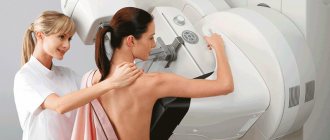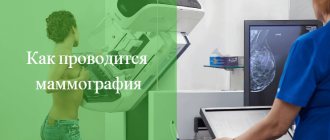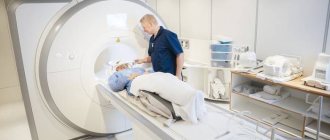All women over 40 years of age are at high risk of developing breast cancer. This is a disease that brings with it pain, changes in the shape and structure of the mammary glands, if it is not detected in time and treatment is not started, then metastases affect the lymphatic system, spread to the neck and chest, which lead to death.
To identify various breast pathologies, there are two main diagnostic methods. In this article we will analyze them in detail and find out which is better – mammography or breast ultrasound.
Mammography or breast ultrasound
What is mammography
Mammography is a method of examining the condition of the mammary glands using x-rays.
Mammography is performed extremely simply: a person stands between two plates of a machine that emits X-rays, and the breast is squeezed between the device and the plate.
At the time of the examination, it is important to fixate in one position so that the picture does not turn out blurry.
Also, before the procedure, the abdominal area must be protected from x-ray radiation, so a special lead apron is placed on it.
The high efficiency of the examination is achieved due to the fact that the mammary glands can be viewed both horizontally and vertically, and X-ray radiation helps to obtain high-quality images.
In modern medicine, there are several types of mammography:
- digital (photos are recorded on electronic media);
- analog (recorded on tape);
- tomosynthesis (this is 3D imaging, special elements scroll around the chest, taking many pictures, which are then combined into one solid 3D image);
- ductography (galactography) – this type of mammography occurs using special X-ray contrast agents. They are introduced into the ducts, a picture is taken and from it their condition can be determined (thickness, damage, elements not inherent in this area).
What is breast ultrasound
A breast ultrasound is a non-invasive procedure in which the breasts are examined using a device that emits ultrasound waves. These waves pass through body tissues that have different densities and are reflected from them, and then this information is transmitted to the device screen. Based on this image, we can talk about the condition of the mammary glands.
During the procedure, the patient should lie down with their arms raised above their head so that the doctor can also examine the lymphatic system in the armpits.
Ultrasound examination of the mammary glands does not cause any harm to the body and is a completely safe diagnostic method.
Main indications for the procedure
According to international recommendations, women aged 40 years and older should undergo mammography annually. This preventive examination of the mammary glands is called screening. If you have a family history of breast cancer (your mother, grandmother, aunt, or sister had it), your doctor may recommend that you start screening at an earlier age, do it more often, or use other additional methods.
If you come in with any symptoms - for example, you have discovered a lump in the gland, pain or other changes - such a mammogram is called diagnostic.
Digital mammography and computer systems for identifying pathological changes have become a global achievement in medicine, which has made it possible to significantly reduce the radiation dose during the study and increase the accuracy of the results.
In our center, in a diagnostic trailer, you can undergo digital mammography using one of the most modern Siemens Mammomat devices - this is the latest development of the German company Siemens.
What is the difference between breast ultrasound and mammography?
As described above, the main difference is in the method itself: in one case, a person is exposed to X-ray radiation, and in the other, to ultrasonic waves.
Also, both examinations have their own indications.
Indications for ultrasound examination:
- heredity (if there are cases of breast cancer or serious hormonal disorders in your family);
- changes in the nipples, their shape or color, the presence of flaky areas;
- breast implant monitoring;
- the need to check lymph nodes and ducts;
- discomfort and pain in the glands;
- swelling and presence of compactions;
- the need to frequently monitor the condition of the mammary glands;
- the need to consider the breast during pregnancy and lactation.
Indications for examination using mammography:
- if seals are felt;
- soreness of the mammary glands;
- if there are diseases of the endocrine system;
- precise determination of the location of the pathology;
- causeless enlargement of one breast;
- as an annual survey of women's health;
- changes in the shape of the nipples, their color and general appearance, as well as pain.
New rules for medical examination
In the near future, workers will begin to undergo a medical examination according to the new rules contained in Order No. 29n. The new regulatory document governing the rules for medical examinations of workers has a limited validity period: its expiration is scheduled for April 1, 2027. The main changes made to the procedure for conducting surveys compared to the previous ones were:
- the possibility of conducting a medical examination by mobile teams of medical specialists - after preliminary completion of mandatory examinations at a medical institution;
- the need to indicate the compulsory medical insurance policy number in the referral for a medical examination;
- the ability to generate a number of important documents, including directions, in electronic form;
- the possibility of carrying out part of the procedures as part of a medical examination in the form of a medical examination;
- linking medical contraindications to the performance of work to the International Classification of Diseases ICD-10.
On what day of the cycle should I do a breast ultrasound?
For both breast ultrasound and mammography, the best time to conduct the examination will be days 5-14 of the cycle (the first day of the onset of bleeding is taken as the beginning of the cycle). During this period, the mammary glands have a homogeneous structure, false cysts do not form in them, they have good echogenicity, etc.
Menopausal women can undergo screening at any time.
If you delve into the process of preparing for an ultrasound or mammography, then a large preparation procedure is not required. If possible, the patient should refuse deodorant, cream or body lotion in the chest and armpit area on the day of the examination. These products, due to some of their components, can impede the passage of ultrasonic waves, and also appear on the image in the form of darkening and spots that will be incorrectly deciphered.
Also, if the procedure is not being performed for the first time, then it is worth providing the doctor with the results of past examinations in order to assess your physiological characteristics and changes in tissue structure.
Preparation of changes to order 302n
Now order 302n, as amended on 01/07/2020, is the main regulatory document that regulates the procedure for conducting mandatory examinations for enterprise employees. This order consists of three main sections:
- a list of harmful and dangerous factors, in the presence of which medical examinations at workplaces become mandatory (Appendix No. 1);
- list of types of work, the performance of which requires the mandatory participation of workers in surveys (Appendix No. 2);
- rules for performing examinations for enterprise personnel.
This legal act came into force on January 1, 2012, that is, almost 10 years ago. It is clear that during this time the situation in the economy and health care has undergone significant changes, which necessitated a revision of the provisions of this document.
To be fair, it should be noted that the issue of changing the regulatory framework affected not only the procedure for conducting inspections of company personnel, but also other areas of activity. The fact is that the Government is now implementing a project of the so-called regulatory guillotine - a large-scale revision of existing legal documents. Based on the results, a significant part of them will be eliminated as containing redundant, duplicative or outdated requirements.
For now, Order 302n on medical examinations, as amended for 2021, continues to be in force. But the Ministry of Health of the Russian Federation for several months developed and at the end of January presented a revised text of a new regulatory act, which involves not only introducing serious changes to the procedure for conducting medical examinations, but also revising the structure of the document itself.
Now the decision has been made finally: on January 29, 2021, the Ministry of Justice registered Order of the Ministry of Health No. 29n dated January 28, 2021. This means that Order 302n of the Ministry of Health on medical examinations, as amended for 2021, has been canceled as of April 1, 2021. Instead of three appendices, only two remain: the procedure for organizing medical examinations and a combined list of contraindications for performing specific types of work.
Experts indicate that the following can be considered the most important changes recorded in the text of the draft.
| Section of the draft order | Changes compared to order 302n |
| Clause 4 of Appendix No. 1 | The possibility of conducting medical examinations by mobile teams of doctors from medical organizations, provided that the employee first undergoes the necessary studies in a medical institution. Examinations by mobile teams can be carried out using telemedicine |
| Clause 9 of Appendix No. 1 | Possibility for the employer to record referrals for medical examinations electronically |
| Clause 10 of Appendix No. 1 | The need for an employee to provide a compulsory or voluntary health insurance policy to undergo a medical examination |
| Clause 10 of Appendix No. 1 | The ability for a medical organization to receive the results of examinations performed as part of the employee’s medical examination in electronic form before he or she appears for a medical examination |
| Clause 11 of Appendix No. 1 | The possibility for the employer to organize a medical examination or annual medical examination of employees in order to take their results into account in the conclusion of the medical commission. In this situation, the cost of medical examination or medical examination services is not taken into account in the contract with the medical institution that conducts the medical examination. |
| Clause 13 of Appendix No. 1 | Issuing a certificate to the employee about the need to undergo an additional examination if it is difficult to interpret the results of the preliminary medical examination. In this case, the employee undergoes the necessary additional examination independently as part of the compulsory medical insurance program |
| Clause 15 of Appendix No. 1 | The ability to issue a medical report in the form of an electronic document equipped with an enhanced digital signature of the health worker. It is necessary to use secure communication channels that prevent third parties from accessing this data |
| Clause 16 of Appendix No. 1 | The need to enter data on the results of a preliminary medical examination into the unified state information system in the field of health care, if the medical organization that conducted the examination has access to this system |
| Clause 18 of Appendix No. 1 | Possibility of conducting an extraordinary medical examination based on the results of a previous examination or after an employee’s incapacity for work if there is a referral from the employer |
| Clause 21 of Appendix No. 1 | Reducing the list of categories of workers for whom information on the appointment of periodic examinations is transmitted to Rospotrebnadzor. In Order 302n this requirement applied to all workers, now only to specialists engaged in the food industry, trade, catering, water supply, medicine and the work of child care institutions |
| Clause 31 of Appendix No. 1 | Issuing a certificate to the employee about the need to undergo additional examination in case of difficulty in interpreting the results of a periodic medical examination. In this case, the employee undergoes the necessary additional examination independently as part of the compulsory medical insurance program |
| Clause 33 of Appendix No. 1 | The need to enter data on the results of periodic medical examinations into the unified state information system in the field of healthcare, if the medical organization that conducted the examination has access to this system |
Which is better: mammography or ultrasound of the mammary glands?
Since breast ultrasound and mammography are aimed at examining the same area, a reasonable question is raised about what is the difference: why is someone prescribed an ultrasound, and someone does an examination using X-rays, which is more informative and more effective than ultrasound or mammography of the mammary glands.
The difference in methods has already been explained above, but now let’s look at the advantages and disadvantages of each method.
Breast ultrasound assessment
Advantages of ultrasound diagnostics of mammary glands:
- painlessness and safety of the procedure (even during pregnancy);
- viewing the organ in real time and the ability to view it from different angles;
- it is possible to examine the condition of the lymph nodes;
- the size of a woman’s breast does not matter – you can examine the tissue of both large and small breasts;
- can be performed for inflammation and injury;
- it is possible to assess blood flow in the glands and neoplasms;
- easy to determine the puncture site;
- high accuracy – 90%.
Flaws:
- inability to make an accurate diagnosis without taking a puncture;
- it is impossible to determine whether a neoplasm is benign or malignant;
- to obtain highly accurate results, modern, expensive equipment is required;
- Also, accuracy and reliability depend on the doctor, his experience, qualifications and attention.
In our medical center you can do an ultrasound.
Breast mammography evaluation
Pros:
- the smallest deviations in the ducts and tissues are visible;
- for example, salt accumulations are visible only on a mammogram;
- it is possible to accurately determine the location of the pathology, size and shape;
- The accuracy of the study is 95%.
Minuses:
- due to the negative effects of X-rays, X-rays cannot be performed frequently;
- it is impossible to examine the condition of the lymph nodes and their work;
- women under 40 years of age may get a distorted result, since the tissues are still too dense.
We looked at the advantages and disadvantages of each method, but it is impossible to say which is better and more accurate – breast ultrasound or mammography:
- If we talk about safety, then ultrasound definitely wins, since it is completely safe for people of any age;
- if we compare both methods according to the degree of comfort, then everyone chooses for themselves, the only point is that the ultrasound will take a little longer, because the doctor also needs to examine the lymph nodes, as well as the ducts;
- As for the cost of examinations, it all depends on the location, but mammography will be more expensive in any case, because the installation itself is more expensive.
Types of medical examinations
Current labor legislation protects the rights of workers to safety and health while performing their job duties. The main tool for achieving this goal is to organize regular monitoring of their condition if the nature of their work poses a potential threat to health. The obligation to organize such work is established by the requirement for medical examinations in Order 302n dated April 12, 2011, with attachments and instructions for employers.
Order No. 302n provides for two main types of inspections performed to minimize the risk of negative impact of production factors on personnel:
- preliminary medical examinations when hiring an employee, which “are carried out to determine the compliance of the health status of the person entering the job with the work assigned to him, as well as for the purpose of early detection and prevention of diseases”;
- periodic medical examinations, which are carried out to assess the dynamics of their condition under the influence of harmful production factors.
Now the order of the Ministry of Health 302n on medical examinations is applied in two cases: if an employee is exposed to harmful and dangerous factors listed in Appendix No. 1 to this order, or he works in one of the job positions specified in Appendix No. 2. In all cases, carrying out the necessary diagnostic tests procedures are carried out at the expense of the employer.
Preliminary inspection
The procedure for conducting preliminary examinations, established in Order of the Ministry of Health and Social Development 302n dated April 12, 2011, as amended for 2021, on referral for a medical examination, is described in Section II. To organize such an examination, the employer draws up a referral to the medical organization, which indicates the nature of the planned work and a list of hazardous factors to which the employee will be exposed. For his part, the employee is obliged to prepare documents proving his identity, and, if desired, an extract from his card, which will more fully establish the real state of his health and its changes.
With these documents he goes to the medical facility. Information about what doctors and tests will be required during the preliminary medical examination when hiring is contained in paragraph 9_1 of the procedure approved by Order No. 302n. It provides that the following are carried out in relation to the employee:
- survey;
- collecting anamnesis and identifying personal risk factors for health changes - for example, smoking, the presence of hereditary diseases, etc.;
- a series of blood and urine tests;
- measurement of arterial and intraocular pressure;
- study of cardiovascular risk and changes in the vascular system;
- fluorography.
Clause 9_1 of the order approved by order No. 302n:
“All women are examined by an obstetrician-gynecologist with bacteriological (for flora) and cytological (for atypical cells) examinations; women over the age of 40 undergo mammography of both mammary glands in two projections. Mammography is not performed if mammography or computed tomography of the mammary glands was performed within the previous 12 months.”
At the end of the examination, a card is filled out for the applicant, which indicates the data of all studies performed, and a conclusion is drawn up, which records the presence of contraindications for future work and the health group.
Clause 14 of the order approved by order No. 302n:
“The conclusion is drawn up in four copies and is issued no later than 5 working days: to the person applying for work, the second is attached to the medical record drawn up in the medical organization where the preliminary examination was carried out, the third is sent to the employer, the fourth is sent to the medical organization, to to which the person entering work is assigned for medical care.”
Periodic inspection
The frequency of periodic examinations in the course of further work is determined by the nature of the employee’s duties and the harmful factors that affect him. Regardless of the established frequency, employees under the age of 21 must undergo examinations annually, clarifies paragraph 17 of the procedure approved by Order No. 302n. Such examinations are carried out in groups: for this, the employer draws up a list of names, which indicates harmful and dangerous factors affecting employees. Information about inclusion in such a list is sent to the territorial body of Rospotrebnadzor within 10 days.
No later than two months before the planned date of the examination, such lists are sent to the medical organization where it will take place. On this basis, she draws up a schedule for performing the necessary procedures. Now, by order of the Ministry of Health 302n, referral for a medical examination by profession involves the following studies:
- survey;
- collecting anamnesis and identifying individual risk factors for health changes;
- calculation of body mass index;
- a series of blood and urine tests;
- measurement of arterial and intraocular pressure;
- electrocardiography;
- identification and changes in the vascular system;
- for women – examination by a gynecologist. Applicants over the age of 40 are required to undergo mammography.
In this situation, the conclusion based on the results of the examination performed is drawn up in five copies, in contrast to the preliminary medical examination. The change here is that an additional fifth copy, with the written consent of the employee, is sent to the Social Insurance Fund. If, based on the results of a periodic examination, contraindications to further work in this position have been identified, the employee is sent for a professional suitability examination to an authorized organization.
Clause 40 of the order approved by order No. 302n:
“If an employee is suspected of having an occupational disease during a periodic examination, the medical organization issues the employee a referral to an occupational pathology center or a specialized medical organization that has the right to conduct an examination of the connection between the disease and the profession.”
conclusions
When prescribing an examination, the doctor will be guided by your symptoms and other indicators, since some types of formations can only be examined with a certain type of examination: cysts are easier to detect on an ultrasound examination, and microcalcifications are well amenable to X-rays. For these reasons, it is impossible to say which is better - a mammogram or an ultrasound of the breast and mammary glands.
To summarize, it is worth saying that both methods are complementary and are often prescribed together in order to obtain the clearest and most clear picture of the condition of the mammary glands.
results
What will the doctor look for when reading your mammogram?
If you keep the results from your previous mammograms, your doctor will compare them with the new test results. The doctor will immediately understand whether any new formations have appeared in the breast, whether existing ones have changed, or whether everything is within normal limits. The specialist will definitely pay attention to any deviations, the occurrence of calcifications or tumors. Calcifications are deposits of calcium in the gland tissue: by their size, location and shape, the doctor can determine whether they pose a risk of malignancy and, if necessary, prescribe additional examinations.
Analysis of mammography results is the most important stage of diagnosis. A mistake is unacceptable when it comes to health and life. It all depends on the knowledge and skills of the doctor. Our doctors in Kropyvnytskyi, at TomoClinic, have extensive diagnostic experience. Specialists have the most modern methods - mammography, ultrasound, fine-needle aspiration biopsy, MRI.










